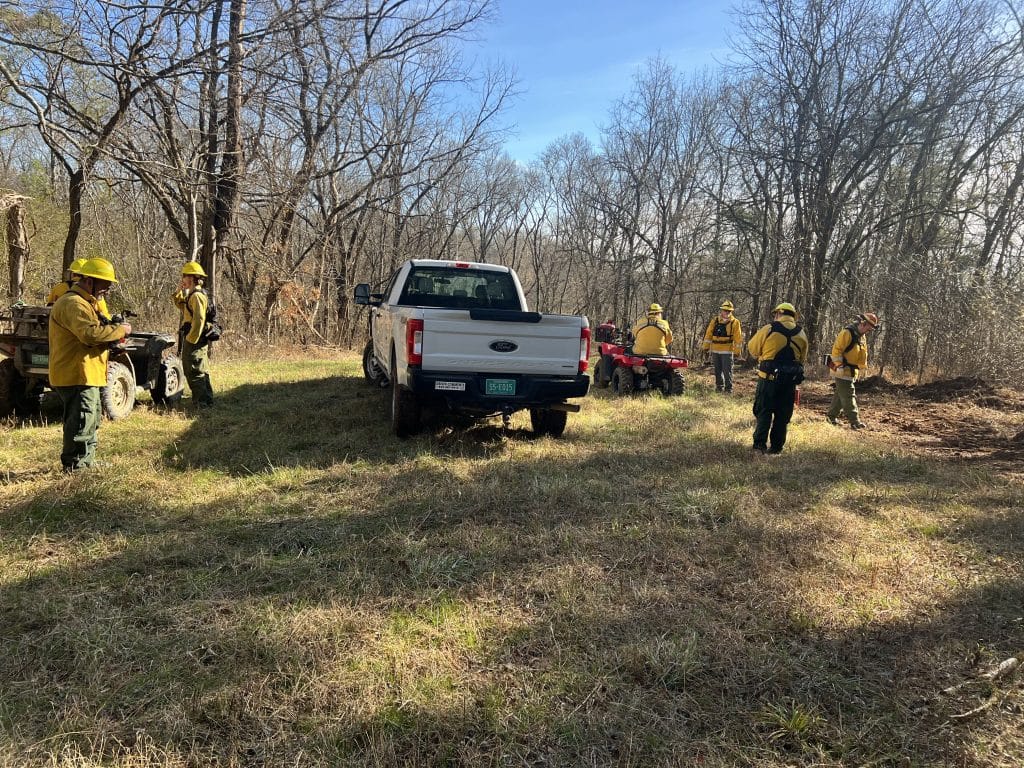The Sugg Property
Part of the 25 Projects for 25 Years series.
The Story and Stewardship of the Sugg Property
Did you know that The Land Trust for Tennessee actively manages certain properties for conservation purposes? The Sugg property is a great example of this. The 852-acre parcel in Maury County, with its rich history and ecological significance, was generously donated to us by the Sugg family, ensuring its protection for future generations. Recently, our team participated in a prescribed burn on the property, marking another chapter in our ongoing commitment to conservation and land management.
- Our Associate Director of Stewardship, Mike Szymkowicz (right), participates in the prescribed burn at the Sugg property.
- Prescribed burn at the Sugg property.
The Sugg Family’s Vision
The story of the Sugg property began in 1955 when Mary Ann and John Sugg’s father purchased the land and ran a dairy farm for many years. The siblings inherited their father’s love for the land and took significant steps to protect and enhance it. In 1990, they enrolled the property in the Conservation Reserve Program (CRP) and planted 240 acres of Loblolly pine on the former farm fields and pastures. This federal initiative aimed to remove highly erodible land from agricultural production and improve environmental health.
Siblings Mary Ann and John’s dedication to conservation was further demonstrated when they donated two conservation easements to The Land Trust in 2001 and 2007. After John and Mary Ann’s passing, the property was bequeathed to The Land Trust, allowing us to continue their legacy without conditions.

Fall Colors at the Sugg property.
Stewardship and Sustainable Management
The Sugg property’s inclusion in the CRP has been pivotal in maintaining its ecological health. CRP contracts, typically spanning 10 years, provide annual payments for compliance with land management agreements. We successfully re-enrolled in the contract in 2021, securing the current term through 2031. The Land Trust for Tennessee’s responsibilities include maintaining the health of the loblolly pines and engaging in mid-management activities.
One such vital management tool is the prescribed burn, recommended for the northern stands of the property. These carefully planned burns serve several essential purposes:
- Improving Wildlife Habitat: Enhances habitat for both game and non-game species.
- Invasive Species Management: Controls the spread and dominance of invasive species.
- Encouraging New Growth: Promotes the growth of native vegetation, increasing biodiversity.
- Nutrient Recycling: Recycles nutrients back into the soil, enriching it for future growth.
- Reducing Competition: Allows native plants to thrive by reducing competition.
- Lowering Wildfire Risk: Decreases the risk of catastrophic wildfires by reducing the fuel load on the forest floor.
- Prescribed burn at the Sugg property.
- Prescribed burn at the Sugg property.
Ensuring Effective Conservation
Our recent prescribed burn at the Sugg property is just one example of the proactive and effective land management strategies The Land Trust employs. By integrating practices like prescribed burning, we ensure that the lands we protect remain healthy, vibrant, and resilient for future generations.

Prescribed burn at the Sugg property.
The Sugg property, with its scenic landscapes and ecological significance, serves as a reminder of the impact that thoughtful conservation can have. We are honored to steward this land, preserving and enhancing the natural beauty of Tennessee in line with Mary Ann and John’s vision.
- Forested area at the Sugg property.
- Sugg Property
As we continue to manage and protect the Sugg property, we remain committed to upholding the legacy of the Sugg family and the principles of conservation they held.
Your support helps make this possible, ensuring that Tennessee’s natural beauty remains protected for generations to come. Find out how you can support The Land Trust for Tennessee’s conservation work.





